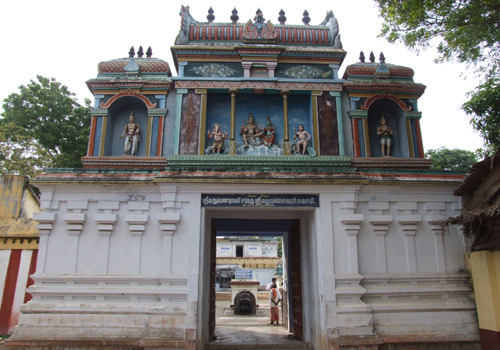The temple is praised by Saint Sundarar in
his Thevaram hymns. This is the 71st
Lord Shiva Temple on the southern bank of Cauvery praised in hymns.
Devas in the celestial world including
their king Indira, Bruhadrajan had worshipped the Lord in this temple. It is built on a land covering an area of 270
feet in length and 135 feet in width. The 30 feet tall 2 tier Rajagopuram is facing east with five Kalasas. Lord Shiva in sanctum sanctorum is facing
east and Mother the south. In a small
hill within the temple are shrines for Lords Nardana Ganapathy, Somaskanda,
Dakshinamurthy, Annamalayar, Brahmma and Mother Durga. In the prakara down the hill are Lords Siddhi
Vinayaka, Subramanya, Chandikeswara, Agastheeswarar, Brahmmapureeswarar,
Bhairava and Saturn (Sani Baghwan), Sun God and Navagrahas the nine planets and
Mother Mahalakshmi. Lord Nataraja graces
from a separate shrine near the sanctum.
This is one of the Mada Temples built by
Chola king Kochenganan. Yama the Lord Death in the south, Varuna the
God of rains in the west, Indira in east and Kubera in the north installed
Shivalingas in the place and worshipped the Lord.
Vayu the God of wind and divine serpent
Adisesha claimed supremacy of their prowess in the court of the Devas. Adisesha covered the peaks of Mount Meru with
his thousand heads. Vayu could not shake
the mount. This created panic in the
world and yielding to the appeal of Devas Adisesha gave in one peak. Vayu shook the peak and took it to south when
one small piece fell in this place, according to sthala purana.
The piece of the peak that fell here became
a small mount which was earlier a plain. The temple is believed to have been built on this mount. Lord Shiva appeared here as a Tejolinga as
the result of the penance of King Bruhadrajan in Krutha Yuga. During the Dwapara Yuga Lord changed all
Devas into bees to protect them from the harassment of demon Vruddhasura. Lord also advised the Devas to make bee-hives
in the sanctum and worship Him. As bees
worshipped here the Lord is named Madhuvaneswarar (Madhu in Sanskrit means
honey), Mother as Madhuvana Nayaki and the place as Madhuvanam. There are bees around the place even now but
they do not harm anybody.
Moolavar: Madhuvaneswarar, Brahadeeswarar
Amman / Thayar: Madhuvaneswari,
Brahadeeswari
Thala Virutcham: Vilwa
Theertham: Brahmma
theertham, Soola theertham
Agamam / Pooja: Shivagama
Old year : 1000-2000
years old
Historical Name : Shivagama
This sivasthalam temple is located in
Nannilam. Nannilam can be reached from Tiruvarur and Kumbakonam. This is one of
the Maadakovils built by Chola king Ko Chenkat Cholan. The shrine for Lord
Shiva is situated at an elevation. The shrines for female deity and that of
Agatheeswarar is located at the lower level. Sun god Sooriyan is said to have
worshipped Shiva at this sthalam.
Lord Shiva in the temple is a
swayambulingamurthy. All festivals mentioned above are organized by Sri
Madhuvaneswara Swami Vazhipattu Kazhagam, a body devoted to celebrating all
festive events.
Vaikasi Visakam in (May June), Tirukarthikai
in (November-December) and Margazhi Tiruvadhirai festivals are celebrated with
procession of Lord. Other festivals are Guru Puja for Saint Sundarar in Aadi
Swati star day in (July-August); monthly pradoshams and Shivrathri and all Shiva
related auspicious days.
It is believed that those bathing in the
sacred spring in Masi Month-(February-March) and worship the Lord will gain all
benefits in life and those worshipping on Ekadasi days-11th day
of full moon or new moon days and pradosha days-13th day in
both fortnights will reach Moksha-salvation.
Devotees perform abishek to Lord and offer
vastras.
The temple is open from 7.00 a.m. to 12.00
a.m. and from 4.00 p.m. to 8.00 p.m.
Sri Madhuvaneswarar Temple, Nannilam-610
105, Tiruvarur district. Contact Number - +91 94426 82346, +91 99432 09771.
Do:
- Do pray your Ishta Devata before pilgrimage to Temple.
- Do contact Temple Devasthanam information centre for enquiry, temple information and for Pooja details etc.
- Do reserve your travel and accommodation at Temple well in advance.
- Do bath and wear clean clothes before you enter the temple.
- Do concentrate on God and Goddess inside the temple.
- Do maintain silence and recite Om Namahsivaya or your Istamantram to yourself inside the temple.
- Do observe ancient custom and traditions while in Temple.
- Do respect religious sentiments at Temple.
- Do deposit your offerings in the hundi only.
Don't s:
- Do not come to Temple for any purpose other than worshipping of God and Goddess.
- Do not smoke at Temple.
- Do not consume alcoholic drinks at Temple.
- Do not eat non-vegetarian food in the Kshetram.
- Do not approach mediators for quick Darshanam. It may cause inconvenient to others.
- Do not carry any weapon inside the temple.
- Do not wear any head guards like helmets, caps, turbans and hats inside the temple premises.
- Do not perform Sastanga Pranama inside the Sanctum Sanctorum.
- Do not take much time while performing Sparsa Darshanam to God in Garbhagriha.
- Do not buy spurious prasadams from street vendors.
- Do not encourage beggars at Temple.
- Do not spit or create nuisance in the premises of the temple.
